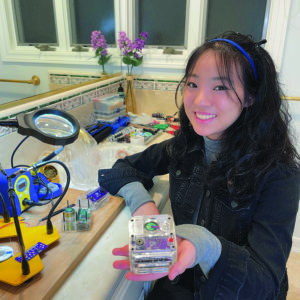
A low-cost seismometer that delivers earthquake early warnings for homes and businesses could someday be as regular a household safety appliance as a smoke detector, says Vivien He, a California high school junior who built such a device for under $100.
The seismometer, about the size of a Rubik’s cube, is encased in clear acrylic, giving it a sleek, consumer-ready look, according to a report by the Seismological Society of America that was published by EurekAlert, the online journal of the American Association for the Advancement of Science.
The device’s geophone detects incoming ground motion, while onboard hardware and software translate the geophone’s electrical signals into a digital waveform.
For earthquakes stronger than the alert threshold set by the user, the device can sound the onboard alarm for onsite warning or send a text message to local subscribers of the regional warning service. The device can be controlled using a smartphone.
Vivien He, a student at Palos Verdes Peninsula High School in Rolling Hills Estates, California, presented her research at the Seismological Society of America’s 2021 annual meeting.
The student researched, designed, built and tested the device over a summer and fall spent at home under COVID-19 restrictions.
Her device provides a consumer-friendly, low-cost alternative to more expensive, scientific-grade systems, giving people in earthquake zones at least a few seconds’ warning to take action and automatically shut down utilities and machinery at work.
Vivien He has set up a nonprofit, Melior Earth, to help her get the device to those who need an inexpensive earthquake early warning system.
The idea for the seismometer came to He after she read a paper about the unusual seismic “quiet” that descended over the Earth when COVID-19 lockdowns brought a halt to much human activity. Vivien He said she wondered if she would be able to measure that quiet from her own home. “And then that quickly evolved into, ‘I wonder if I can measure in my own home and apply it to earthquake early warning?’” she said.
That got He reading about earthquake early warning and building a thick three-ring binder of highlighted papers, many of them from SSA journals. The research gave He confidence that she could build a low-cost earthquake early warning device, but she had little expertise that would help her figure out the components, the programming and the design, so she went to a Massachusetts Institute of Technology “hackathon,” where she was told that the hacker’s secret is to Google everything.
“And that’s kind of like what I did for this project, like, oh, I don’t know how this works, just Google it,” He said.
The final design contains a data card that can hold up to four years’ worth of standard earthquake waveform files that can also be used for seismological studies.
Vivien He plugged in her first seismometer one night last September. When she awoke the next day there had been an earthquake in Los Angeles. She compared the seismic signal captured by her device to one produced by a U.S. Geological Survey station near her home, and the waveforms appeared the same, she said.
He’s seismometer has since successfully detected several earthquakes in Southern California. She is now a finalist in the International Science and Engineering Fair, moving her on to compete at the international level. She has also won the Association of Women Geoscientists Award, the Cheryl Saban Self-Worth Foundation for Women & Girls 1st Place Award and Scholarship, and the Professional Engineers in California Government’s Marilyn Jorgenson-Reece Award of Excellence and Scholarship.
Vivien He is now working on getting a utility patent for the device. She has also set up a nonprofit, Melior Earth, to drive consumer adoption for the device to make earthquake early warning accessible for lower-income countries, regions and populations.
Vivien He said she is not focused on monetary gain, but the science of it, and the impact in general on earthquake disaster prevention.





